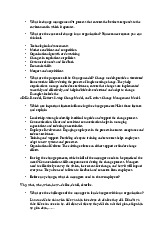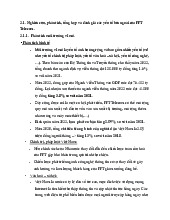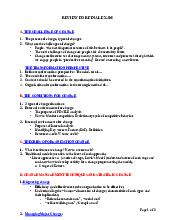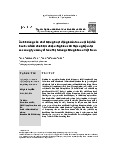



















Preview text:
lOMoAR cPSD| 47206071 Chapter 1 Question 1 Change ( v) is:
a. -An alteration or modification
b. -The replacing of a state of affairs that exists now with something different.
c. -to move from one to another
d. -A new or refreshingly different experience. Question 2 -external pressures is: a. policies and procedures
b. pay structures and employee feedback c. accommodation issues d. technology Question 3 Change ( v) is:
a. -An act or process through which something becomes different
b. -An alteration or modification
c. -A new or refreshingly different experience.
d. to make or become different Question 4 -external pressures is:
a. pay structures and employee feedback
b. government legislation and customer feedback
c. pay structures and employee feedback. d. accommodation issues Question 5 lOMoAR cPSD| 47206071 Change ( v) is:
a. -An alteration or modification
b. -The replacing of a state of affairs that exists now with something different.
c. -to make different, alter, modify
d. -A new or refreshingly different experience. Question 6
Change management is a systematic process that helps individuals, teams and
organizations adapt and succeed during transformation. It includes activities such as:
•Planning and implementing changes effectively.
•Manage the impacts of change on people and systems.
•Help people adapt to new environments. Select one: True False Question 7
Change ( n) is defined below except:
a. -The replacing of a state of affairs that exists now with something different.
b. -A new or refreshingly different experience.
c. -to make different, alter, modify
d. -An alteration or modification Question 8 internal pressures is: a. global markets
b. pay structures and employee feedback.
c. new competitors or technology lOMoAR cPSD| 47206071
d. government legislation and customer feedback Chapter 2 Question 1
Vertical organizational structure: a.
Hierarchical, with graduating levels of responsibility and
power in one direction and diminishing levels of autonomy and authority in the other.. b.
Employees are empowered and encouraged to participate in the
organization's decision-making process c. Distribution of power
d. Level of supervision is broadened since an employee is not accountable to
a specific manager, thus any manager can supervise any employee. Question 2
"•Combine market and functional focus
-project management structures, accountable for the project, and
-functional structures, accountable for each discipline, say engineering, operations
-two bosses; the departmental bosses and the project leader. •Pressures to change:
-problem of reconciling the need for flexibility with the need for project coordination and control.
-good working relationships between project and functional
management" This is type of structure : a. The product structure
b. The Matrix Structure.
c. The functional structure
d. The simple or entrepreneurial structureQuestion 3
"•Similar activities are grouped into departments: personnel, marketing, finance, operations...
•Coordination is achieved through a board of directors or management committee. •Pressures to change: -further growth, lOMoAR cPSD| 47206071 -geographical dispersion
-product/ service diversification" This is type of structure :
a. The simple or entrepreneurial structure b. The product structure c. The Matrix Structure.
d. The functional structure. Question 4 The Product Structure.is: a. lOMoAR cPSD| 47206071 b.
c. Đây là đáp án d. lOMoAR cPSD| 47206071 Question 5 The Functional Structure.is: a. Đây là đáp án b. lOMoAR cPSD| 47206071 c. lOMoAR cPSD| 47206071 d. Question 6
The simple or entrepreneurial structure.is: a. b. Đây là đáp án lOMoAR cPSD| 47206071 c. d. lOMoAR cPSD| 47206071 Question 7 The Divisional Structure.is: a. b. lOMoAR cPSD| 47206071 c. d. Đây là đáp án lOMoAR cPSD| 47206071 Question 8
Transformation is not redefining what something is (the current state). It begins by
first assessing the present to the desired future. Select one: True False Question 9 Rethinking Process is:
•Processes in an organization :represent all the activities in order to transform input
to output, and that will have a value for consumers. Select one: True False Chapter 3 Question 1 lOMoAR cPSD| 47206071
Change management is all of the following except:
a. Comprises means of identifying vision, strategy, business model and
strategic implementation
b. Starts by taking such decisions as inputs and looks at how we can put them into effect.
c. Deals with behavior, structures and configurations, delivery…
d. Is in the field of measurement, efficiency and effectiveness.
Question 2 in Linear Approaches : Non-linear change refers to the following:
a. often abrupt, unexpected, and difficult to predict.
b. Running a single task to completion
c. Finite beginning and ending
d. Predictable, based on past experience Question 3
Strategic management is all of the following except:
a. Seeks to help us decide what we should do.
b. To look at environmental uncertainty regarding markets, competitors, technology…
c. Deals with behavior, structures and configurations, delivery…
d. Comprises means of identifying vision, strategy, business model and strategic implementation Question 4 "•Theory E (Economic)
-maximize shareholder value through financial incentives, downsizing and divestment.
•Theory O (Organizational Capabilities)
-performance improvement through incremental interventions to the organizational
culture, capability and the promotion of organizational learning." This is the theory of: lOMoAR cPSD| 47206071 a. George Bernard Shaw
b. Beer and Nohria (2000)
c. Kurt Lewin's Change Model (1947) d. Frederick Douglass Question 5
Linear approach: Kotter (1996) includes:.....stage a. 8 b. 4 c. 5 d. 3Question 6
"If you have a cube of ice but realize that what you want is a cone of ice, what do you do?
-First, melt the ice to make it susceptible to change (unfreeze).
-Then, mold the iced water into the shape you want (change).
-Finally, solidify the new shape (refreeze)." This is the theory of: a. Frederick Douglass
b. Kurt Lewin's Change Model (1947) c. George Bernard Shaw d. Peter F. Drucker Question 7
Strategic management is the following content:
a. Starts by taking such decisions as inputs and looks at how we can put them into effect.
b. To look at environmental uncertainty regarding markets,
competitors, technology…
c. Is in the field of measurement, efficiency and effectiveness.
d. Deals with behavior, structures and configurations, delivery… lOMoAR cPSD| 47206071 Question 8
The “clinical” approach includes the following except a. organizational culture b. organizational climate c. organizational strategies d. Linear change Chapter 4 Question 1
CONVERGENCE PHASE: begins with imitation of competitors’ best features,
and then leads to an emphasis on reducing costs. Select one: True False Question 2 Closed change : a. •Control is impossible
b. •The purpose of the task is still known, though the estimate of effort is
somewhat blurry due to many possible changes.
c. •Clear problem + Clear connection between cause and effect • People
can accurately forecast the effect.
d. •The situation is unique and/or unclear Question 3 Open-ended change :
a. •The situation is unique and/or unclear
b. •The effect of one particular change cannot be determined accurately.
c. •The purpose of the task is still known, though the estimate of effort is
somewhat blurry due to many possible changes.
d. •Possible to control this change in a formal and analytical way Question 4 lOMoAR cPSD| 47206071 Contained change :
a. •The effect of one particular change cannot be determined accurately.
b. •The situation is unique and/or unclear
c. •Control is impossible
d. •Possible to control this change in a formal and analytical way
Question 5 in PESTLE model: ECONOMIC is: a. local regulations. b. lifestyle changes c. information technology
d. Employment rates, wage rates
Question 6 in PESTLE model: SOCIO- CULTURAL is:
a. willingness and ability to move
b. Employment rates, wage rates
c. information technology d. local regulations.
Question 7 in PESTLE model: POLITICAL is: a. local regulations. b. lifestyle changes
c. Employment rates, wage rates
d. information technology Question 8 in Resource Audit: lOMoAR cPSD| 47206071
"What is the age and condition of our plant or equipment? " this is factor: a. Physical resources b. Intangibles c. Financial resources d. Human resources Chapter 5 Question 1
How many steps does organizational diagnostics include? a. 5 b. 4 c. 3 d. 6 Question 2 Social Man is:
a. People can adopt new motives as a result of their experiences
b. Employees are primarily motivated by economic incentives.
c. People are basically motivated by social needs through relationships with others
d. People are primarily self-motivated and self-controlled Question 3
Efficiency: achieving existing objectives with acceptable use of resources Select one: True False Question 4
Determine the reason for change is the step: a. 2 b. 3 lOMoAR cPSD| 47206071 c. 4 d. 1
Question 5 organizational diagnose IS:
is the process of gathering and analyzing information to evaluate an organization's
readiness and ability to succeed in implementing change. Select one: True False Question 6
Effectiveness: achieving existing objectives with acceptable use of resources Select one: True False Question 7 Self-Actualizing Man is:
a. People are primarily self-motivated and self-controlled
b. People are basically motivated by social needs through relationships with others
c. People can adopt new motives as a result of their experiences
d. Employees are primarily motivated by economic incentives. Question 8
Assessing the current environment is the step:
a ....................................................................................................................... 4
b ....................................................................................................................... 5
c ....................................................................................................................... 7
d ....................................................................................................................... 8 lOMoAR cPSD| 47206071 Chapter 6 Question 1
Deployment and support is the step: a. 4 b. 2 c. 1 d. 3 Question 2 Internalization is the step: a. 5 c. 2 d. 3 e. 4 Question 3
How many steps does the coping cycle include? a. 5 b. 4 c. 2 d. 3 Question 4 Discarding is the step: a. 1 b. 3 c. 2 d. 4 Question 5
Managing major changes is a simple and challenging process, requiring thorough
technical preparation and execution skills. lOMoAR cPSD| 47206071 Select one: True False Question 6
Some important steps in managing major changes include: a. 3 b. 5 c. 4. d. 3 Question 7
Transition is the reaction to change at a personal level, including uncertainty, confusion and fear. Select one: True False Question 8
Evaluation and reinforcement is the step: a. 4 b. 2 c. 3 d. 1 Question 9
Planning and communication is the step: a. 2



